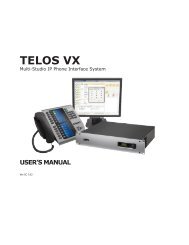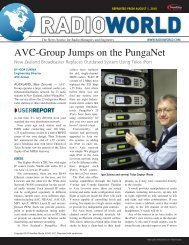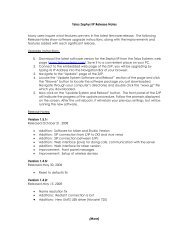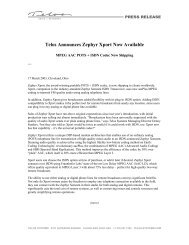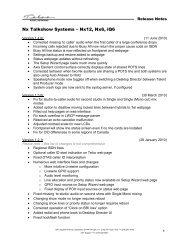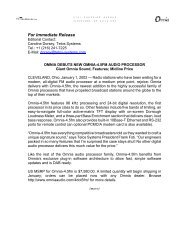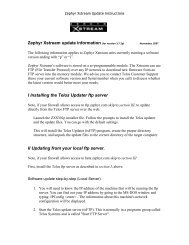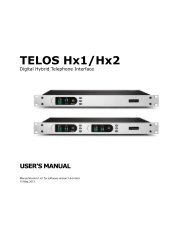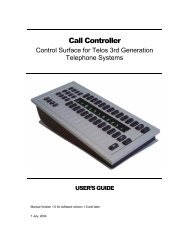NOW! 12-13 - Telos
NOW! 12-13 - Telos
NOW! 12-13 - Telos
Create successful ePaper yourself
Turn your PDF publications into a flip-book with our unique Google optimized e-Paper software.
» Stereo FM<br />
TECHTALK BLOG<br />
TELOSALLIANCE.COM/BLOG<br />
» SCA subcarriers (including digital SCAs)<br />
» RBDS digital subcarriers<br />
» Extended Hybrid IBOC sidebands<br />
SSBSC generates modulation peak overshoots and increased<br />
sideband amplitudes, at least theoretically, which may increase<br />
audio distortion of the demodulated FM signal under multi-<br />
path reception conditions. It is essential, then, to test the above<br />
transmission modes with multipath propagation. NPR Labs has<br />
worked extensively with both over-the-air and laboratory-simu-<br />
lated multipath; in our experience, laboratory simulated multi-<br />
path can be made indistinguishable from over-the-air multipath<br />
conditions, and they avoid the signal instability, environmental<br />
noise and signal interference that hinder the accurate com-<br />
parisons. These other degradations can be added in controlled<br />
amounts to the receiver under test, if desired, although they do<br />
not appear to be necessary for this testing.<br />
The dificulty with ixed multipath scenarios, whether over-the-<br />
air (stationary) or simulated, is that they represent only one<br />
condition, requiring measurements or audio sample recordings<br />
with many separate amplitudes and phases of the “paths” to<br />
represent the scenario. NPR Labs has been successful in putting<br />
the scenario “into motion,” causing the scenario to pass through<br />
many combinations of amplitudes and phases within one time<br />
interval of the multipath simulator. Multipath proiles should<br />
include an urban condition (short path delays with higher ampli-<br />
tudes), rural (longer path delays with lower amplitudes relative<br />
to the direct path) and a no-multipath condition.<br />
The time interval of the multipath simulator, including multipath<br />
fading, can provide an audio sample for assessment by listeners<br />
in a controlled subjective test. Listeners provide the basis for fair<br />
and understandable ratings of reception quality. NPR Labs has<br />
also used Fast Fourier Transform analysis to produce frequency<br />
distribution histograms from digital (wave ile) recordings of<br />
the multipath interval, thereby providing an objective measure<br />
of the distortion products. Either method is appropriate to this<br />
study: the listener-based tests are more expensive but simpler to<br />
interpret, while the FFT analysis is faster and permits more con-<br />
ditions to be tested.<br />
It is important to test reception compatibility with a variety of<br />
receivers, as the impacts may vary with the internal architec-<br />
ture and performance of the receiver. A test matrix involving the<br />
quality rating with different multipath proiles for each receiver<br />
would be an appropriate output to demonstrate the levels of<br />
compatibility. The matrix could include other processing condi-<br />
tions for the SSBSC transmission as well.<br />
Testing compatibility with RBDS and IBOC DAB are simpler since<br />
the failure of digital reception can be used to determine the po-<br />
tential impact of SSBSC transmission. It is possible that severe<br />
degradation of analog FM stereo occurs before failure of digital<br />
reception. This would simplify the extent of these tests.<br />
BROCHURES<br />
OMNIAAUDIO.COM/BROCHURES<br />
SOFTWARE UPDATES<br />
OMNIAAUDIO.COM/SOFTWARE<br />
Coverage enhancement is a simpler, and optional, consideration.<br />
The improvements could be determined by changes in audio<br />
signal-to-noise ratio with stereo FM receivers equipped with<br />
suitable SSBSC decoders. NPR Labs’ standard approach uses a<br />
frequency-weighted quasi-peak psophometer, compliant with<br />
ITU-R Recommendation 468-1, which correlates well with listen-<br />
er’s assessments of noise-limited reception. A more comprehen-<br />
sive test would include multipath reception conditions, to ensure<br />
that the potential improvements are not degraded by multipath<br />
propagation effects.<br />
The test of effects to reception on irst and second-adjacent<br />
channels is conducted similar to the above: WQPSNR is mea-<br />
sured by psophometer as the ratio of undesired (SSBSC) carrier<br />
to desired carrier is varied. The RF protection ratio at which the<br />
same WQPSNR is achieved with SSBSC, relative to standard DSB-<br />
SC, is noted. The undesired carrier should be modulated by an au-<br />
dio program signal, or simulated program signal, that represents<br />
the RF spectral occupancy of typical FM stations. More than one<br />
program modulation could be considered, such as high-density<br />
music and low-density music. The test matrix would tabulate the<br />
change in RF protection ratios against a variety of receiver types.<br />
Again, a more comprehensive test should introduce multipath<br />
proiles to the matrix to ensure that multipath propagation does<br />
not increase the RF protection ratio” [6].<br />
As of this writing, the author is in the process of assembling a<br />
proposal for the AFAB subgroup of the NRSC that will propose<br />
formalized industry testing of the SSBSC transmission method.<br />
IN CLOSING…<br />
An opportunity presents itself to our industry. The chance to im-<br />
prove the sonic performance of conventional FM-Stereo radio.<br />
Even if a subtle improvement, through reduction of perceived<br />
multipath, offers the possibility of people listening longer to FM<br />
radio, everyone gains. Together, equipment designers, receiver<br />
manufacturers and broadcasters can work together to further<br />
investigate the viability of SSBSC as an optional transmission<br />
method. Thus far, the initial results look very positive, based on<br />
feedback from broadcasters. It is possible that some hurdle ex-<br />
ists, and hopefully through joint, mutual effort of our industry,<br />
we’ll be able to determine what to do, should that be the case.<br />
It must be noted there is an extremely large and positive inter-<br />
est in this topic. Should the reader desire to become involved,<br />
please contact this author, or a member of the AFAB subgroup<br />
of the NRSC.<br />
After 50 years of stellar operation, a modiication to the rules<br />
and regulations governing FM-Stereo, would be a wonderful way<br />
to celebrate this technology! More importantly, the benefactors<br />
are the general public-radio listeners, as audible annoyances will<br />
be suppressed, and in some cases, eliminated. At a time when<br />
broadcasters are looking to ind every possible way to enhance<br />
their customers (the listener’s) experience, this change in the<br />
rules would beneit everyone. This concept offers total upside,<br />
with – as of yet -no downside at all.<br />
For references and acknowledgements see:<br />
omniaaudio.com/downloads/white-papers/MPX-SSB-White-Paper.pdf<br />
FIND A DEALER<br />
OMNIAAUDIO.COM/BUY<br />
AUDIO PROCESSING | FM | FM+HD | AM | MULTICASTING | CODED AUDIO | STUDIO APPLICATIONS<br />
OMNIAAUDIO.COM<br />
59




